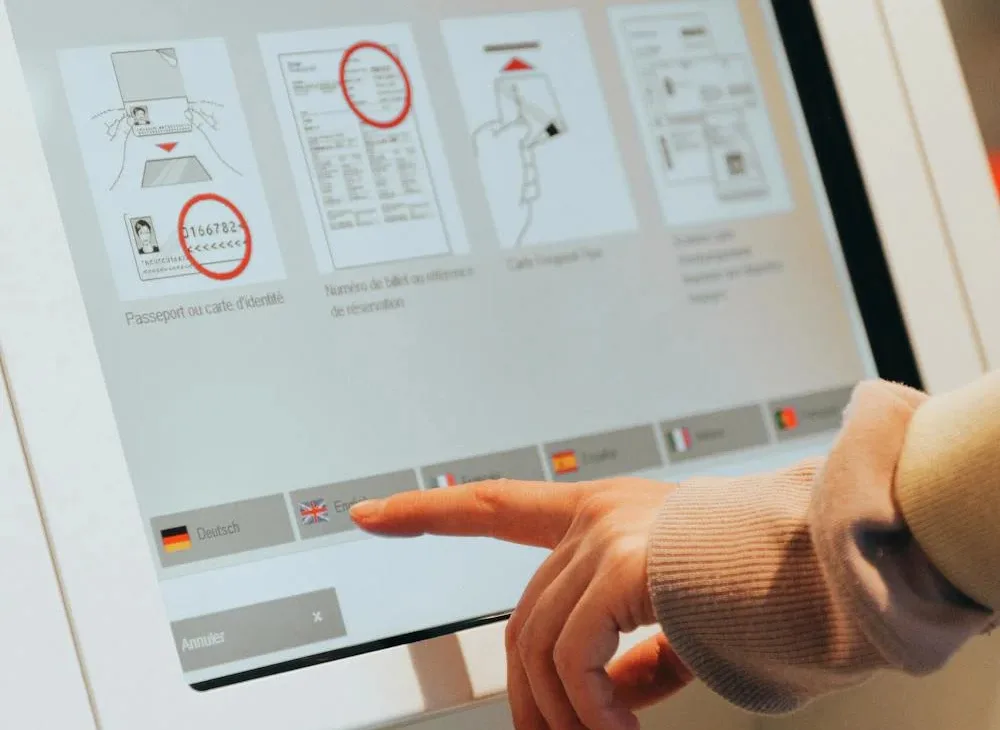One of the approaches to developing engaging user experience for people to interact with totems and digital kiosks is user-centred design (UCD). These interactive platforms are essential points of contact between companies and their clients, offering changes for information sharing, brand interaction, and transactional activity. Digital kiosks and interactive totems hold immense potential, but unlocking it hinges on prioritizing user experience (UX). However, the decisions made in the designing department aimed at ensuring a smooth user experience have a major influence on how successful these interactions are. Let us dive into some of the user-centred design principles.
User-Centred Design Principles
Empathy
In user-centred design, empathy involves comprehensive research and observation to gain an understanding of users’ needs, objectives, and frustrations. By engaging in user research, building personas, and putting themselves in consumers’ shoes through observation, and contextual inquiry, designers may develop empathy.
For instance, iterative design processes that actively listen to user feedback and implement them ensures that their solutions strike an emotional chord with people. For designers to produce more effective and human-centred design, they have to develop products and services that meet the users’ functional needs and resonate with their underlying wants and desires by fostering the feeling of empathy.
Usability
Regardless of consumers’ level of expertise in technology, usability is a core concept in user-centred design emphasizing in the creation of interfaces that are clear, intuitive, and simple to learn and use. These interfaces should alleviate cognitive stress and promote effective interactions.
Designing for usability also means prioritizing consistency, simplicity, and clarity in content display and interface components. It usually involves making sure that the processes run well, efficiently managing mistakes, and giving constructive feedback. Moreover, in this context, interfaces should be inclusive and accessible, meeting the requirements and abilities of many people.
Iterative Design
To produce the best possible user experience for the masses, iterative design is a component of user-centred design. It emphasizes the significance of continuously improving interfaces through a cycle of prototyping, testing, and refinement based on the users’ input. This technique recognizes that creating user interfaces is a continuous process that changes depending on user demands and consumer behavior.
For instance, prototypes are made by designers to visualize ideas and obtain early user input, guiding further revisions. Usability and iterative design goes hand-in-hand. It directs the creation of interfaces that put the needs of users – above all else, regardless of their level of technical expertise. This is usually done by emphasizing clarity, intuitiveness, and simplicity of use.
Context
Context is an integral concept in user-centred design. It emphasizes how important it is to take the physical surroundings and user flow into account when creating interactions. It highlights the degree to which user interaction with the system affects how successful interface design is. To ensure the interface integrates into the user’s environment, designers need to consider aspects like noise levels, physical surroundings, lighting, and ergonomic issues. Additionally, designers will be able to create natural and seamless interaction experiences by having a thorough grasp of the user flow within the system including entrance points, task sequences, and departure paths.
In the current digital environment, developing user-friendly interfaces and stimulating interactions are essential. Users want smooth interactions that take little to no effort and provide the highest level of enjoyment from websites, mobile applications, and interaction. Here are some of the best practices for engaging experiences.
Best Practices for Engaging Experiences
Visual Hierarchy
A vital component to create engaging experiences is visual hierarchy because it stimulates user engagement. This means arranging data to direct consumers’ attention. Some of the aspects that designers use to create a clear hierarchy are size, color, typography, and spacing. It helps in drawing users’ attention to the most crucial and pertinent components on the interface.
Through the deliberate use of visual signs such as bold colors, larger font sizes, and plenty of white space to emphasize important components, designers can efficiently convey to users the relative significance of different aspects and optimize user experience. In addition to improving usability and streamlining intricate information structures, a clear visual hierarchy also increases user engagement by drawing users’ attention to interactive aspects and call to action.
Simple Interactions
Intuitive interfaces and engaging experiences are built on simple interaction, making it easy for people to interact and explore digital platforms. Maintaining touch targets big enough to appeal to users with different dexterities and device sizes is essential since it lowers the possibilities of errors and frustration. Users can navigate with confidence when interactions between the interface are consistent and familiar, preventing unexpected occurrences. Furthermore, providing users feedback such as animation or visual cues improves their sense of control and comprehension by informing them of the results of their actions.
Storytelling
The best practice for developing user-friendly interfaces and engaging experiences is storytelling. This enables designers to craft narratives that connect with people on a deeper level. Designers have the ability to entice consumers into immersive digital experiences, promoting exploration and engagement by creating intriguing material that grabs attention and piques interest. For example, texts should be used sparingly in effective storytelling, conveying ideas concisely while enhancing images and multimedia components. Utilizing multimedia such as sounds, pictures, animations, and videos, improves the storytelling process by evoking feeling while adding depth to the story. By doing so, designers can produce unique user experiences that inspire users, encouraging greater interaction and establishing greater bonds between the user and the interface’s content.
On the other hand, the way businesses interact with their audiences is changing as a result of a number of new trends and technology. The opportunities for creative marketing strategies are also growing quickly, running from immersive experiences like augmented reality (AR), virtual reality (VR), and AI-powered content suggestions. With the help of these technologies, businesses can provide customers with personalized experiences, increasing engagement and brand loyalty. Let us expose some of the emerging trends in digital marketing involving digital kiosks, interactive totems, and signage software.
Emerging Trends in Digital Marketing
AI-powered Content Recommendations
Digital marketing is heavily revolutionized by technologies powered by AI, allowing for personalized content suggestions based on the preferences and behaviors of individual users. Now, AI algorithms can anticipate user interests by evaluating user data in real-time. Based on this, they can modify content displays on interactive totems and digital kiosks.
For example, AI may provide promotion, product, or content suggestions based on user demographics and historical interactions. Furthermore, marketers can improve the efficiency of their campaigns and ameliorate their content strategy with the use of AI-powered analytics.
Augmented Reality Experiences
By overlaying digital material over the real world, augmented reality technology can create captivating and interactive experiences for viewers. AR has the potential to convert status displays into dynamic narrative platforms, particularly in the context of digital kiosks and interactive totems.
For example, retailers may utilize AR to let customers virtually try on clothes or see how certain furniture will look in their homes. Businesses can differentiate their brand and stand out from their competitors by incorporating augmented reality experiences into their digital signage software to create memorable and shareable interactions.
Virtual Reality Experiences
By immersing people in virtual worlds, VR technology opens up new possibilities for brand storytelling and experience marketing. Though VR is typically linked with entertainment and gaming, it is currently being used more and more in marketing to produce memorable and significant experiences. Users can now enjoy virtual tours, immersive product presentations, and branded entertainment experiences equipped with virtual reality capabilities.
For example, automakers can utilize virtual reality (VR) to let buyers virtually test drive or explore automobile interiors to ensure they are the right fit. Businesses may also enhance brand relationships, engage audiences in new ways, and create an impact on customers via VR experiences.







